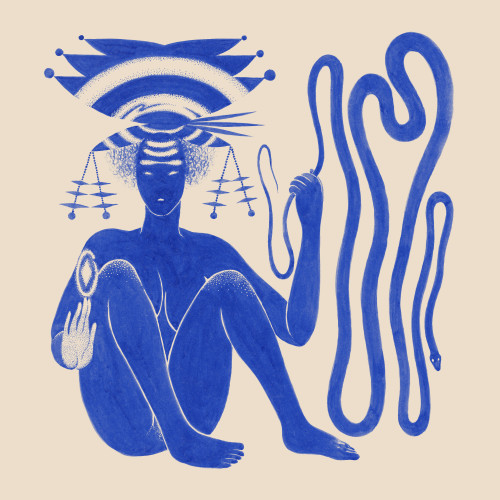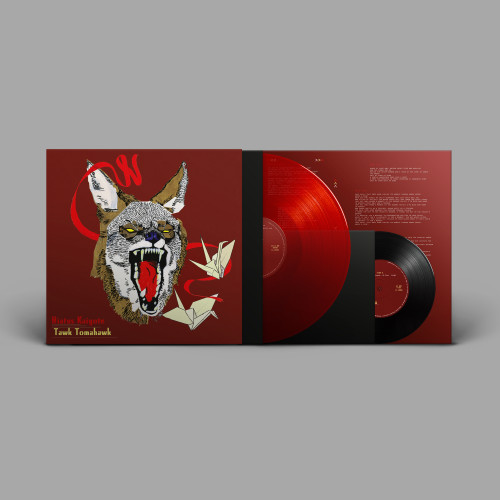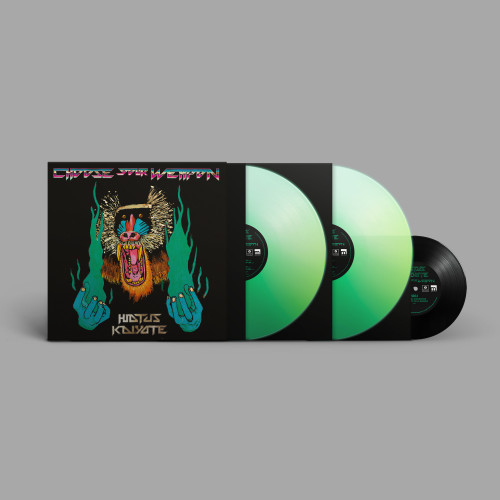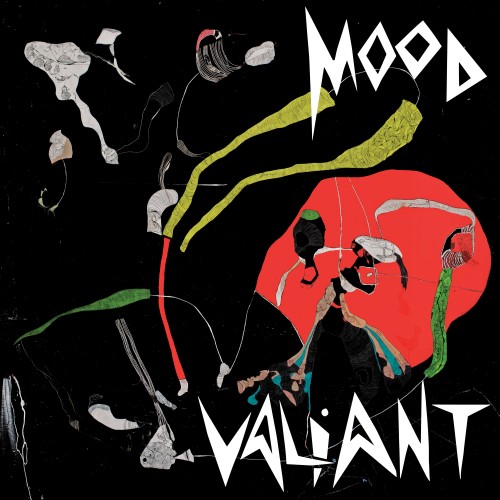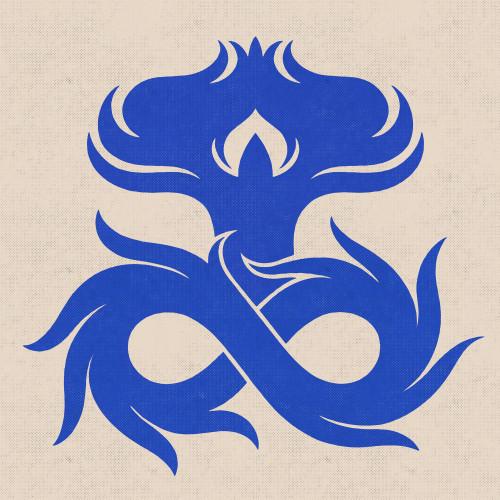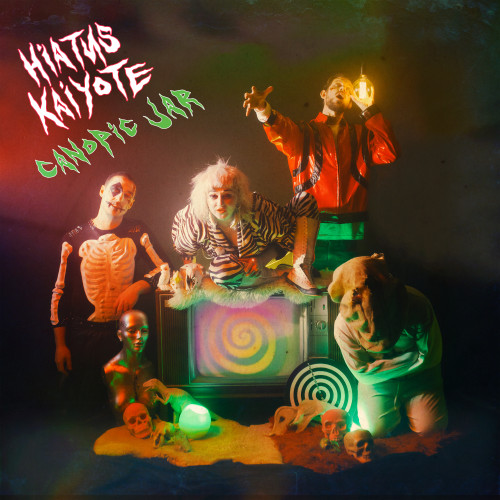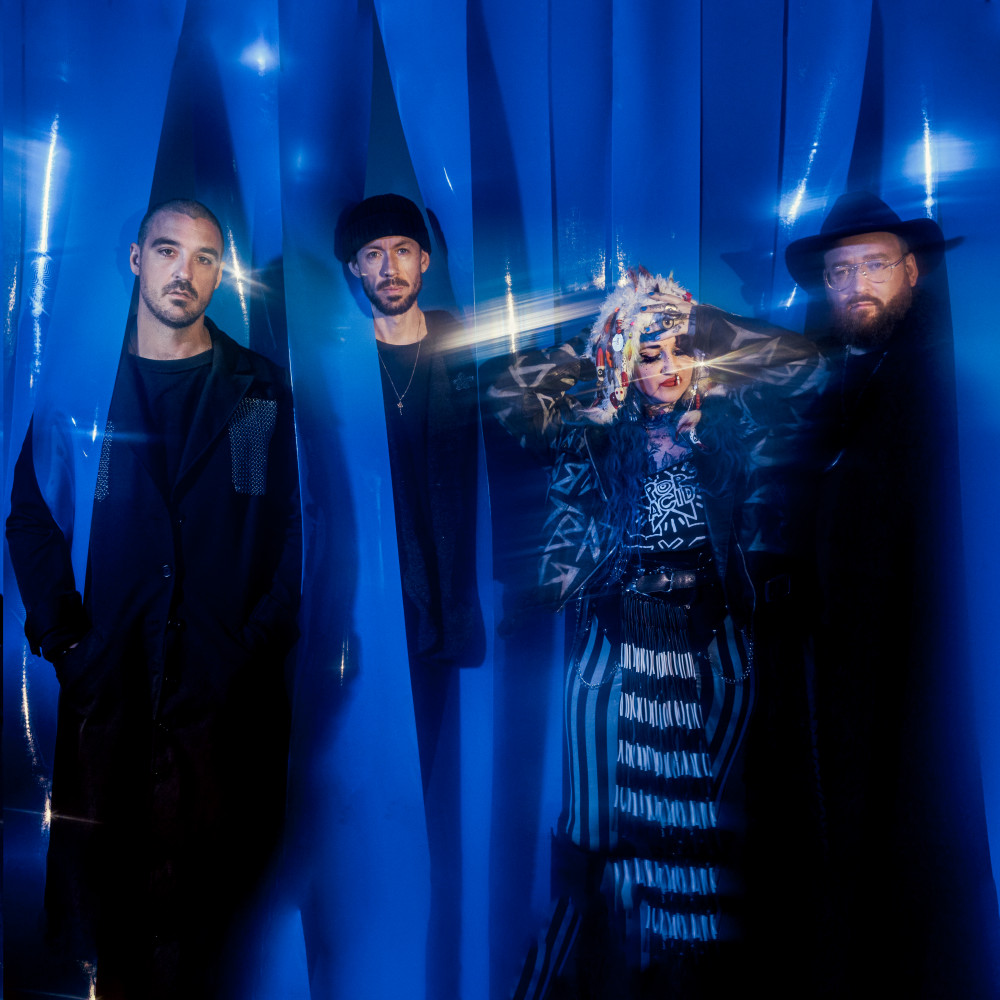
Hiatus Kaiyote
On Brainfeeder
BIOGRAPHY
A great band is a group of musicians who share one nervous system. It’s an alchemy that goes beyond hours of practice and years spent together. It’s about sensing as much it is playing, anticipating without being warned, knowing without being told. To hear and see a great band at work is to witness a miracle. Hiatus Kaiyote would never make such a claim about themselves. So let us make it: On their fourth album, Love Heart Cheat Code (Brainfeeder Records/Ni...
A great band is a group of musicians who share one nervous system. It’s an alchemy that goes beyond hours of practice and years spent together. It’s about sensing as much it is playing, anticipating without being warned, knowing without being told. To hear and see a great band at work is to witness a miracle.
Hiatus Kaiyote would never make such a claim about themselves. So let us make it: On their fourth album, Love Heart Cheat Code (Brainfeeder Records/Ninja Tune), you get to hear one of the greatest bands in the world, working one miracle after another.
The chemistry has been strong since their first jam session in 2011, in the living room of a Melbourne, Australia “share house.” Guitarist-vocalist Naomi “Nai Palm” Saalfield, bassist Paul Bender, keyboardist Simon Mavin, and drummer Perrin Moss released their first album Tawk Tomahawk the following year. It became a surprise hit, garnering a Grammy nomination. It connected them to a global community of fans who saw their music as a new and thrilling blend of genres, and perhaps beyond genre—who else but Hiatus could unite an audience of both metal and neo-soul fans? Their second LP, 2015’s Choose Your Weapon, made good on that promise: skillful songwriting and daring harmony and rhythm, all powered by incomparable musicianship. Several world tours and a second Grammy nomination followed. Then came 2021’s Mood Valiant, a reflective beauty created and issued in the midst of the pandemic, and cause for yet a third Grammy nomination. In that time, Hiatus Kaiyote have graced stages from Coachella, Fuji Rock, and the Sydney Opera House to the Hollywood Bowl and Red Rocks; been sampled by hip-hop and R&B icons from Kendrick Lamar and Anderson .Paak to Jay-Z and Beyonce; and been lauded in The New York Times and Rolling Stone. But what the years have really wrought for these four artists is a kind of precious interconnection.
“I think there’s a massive level of trust that we’ve developed over time,” Simon says. “That means we can push the music in whatever way we want, and get as creative as we want, which has been a big mind opener for me.” It’s a sentiment echoed by his partners. “The reason why I never fucking collaborate with anyone else is because I’m so spoiled,” says Nai. “I can go to any one of my bandmates, sing a melody at them, and I’ll hear what I want to do harmonically, but I have no theory for communicating that. And they’re so patient with me, and they trust in me.”
Love Heart Cheat Code is a snapshot of four musicians dancing together on the edge, 11 playful, exuberant tracks that feel light and shine light —from the opening flourish of “Dreamboat” to the closing chants of their interpretation of “White Rabbit.” As fans might expect, Love Heart Cheat Code is filled with any number of incredible performances: Bender’s bass chords on “Dimitri,” Perrin’s polyrhythmic crescendo on “Make Friends,” Simon’s galloping piano on “How to Meet Yourself,” and Nai’s guitar and vocal virtuosity throughout “Everything’s Beautiful.”
Yet, for a band that made a name for itself with its complexity, one of the most striking things about Love Heart Cheat Code is its simplicity. Bender reflects: “There’s a little bit more embrace of some fairly classic songwriting forms. Over time, we’ve been developing the ability to do songs that are very clear, lyrically straight up, which is its own challenge.” That clarity comes from another kind of trust: self-confidence. “I’m a maximalist. I complicate fucking everything,” Nai laughs. “But the more you go through things in life, you become more relaxed and uninhibited. Sometimes you can still have depth and reach people and really stop dancing around the fact: What do you want to communicate to people? And I feel like this album is a result of that clarity for us. We didn’t need to spell out complexity if the song didn’t call for it.”
That ease has created songs that verge on the anthemic. The melody and lyrics for “Everything’s Beautiful” emerged, McCartneyesque, from a dream — I was walking/Down on my way/I was fine — the music itself a brisk walk in the sun. Nai calls the ballad “How to Meet Yourself” the “most direct, sincere lyric that I think I’ve ever written: I came here to make you cry. My greatest reward as artist is to be able to help people unlock tension. And sometimes the way to help people unlock tension is to create something light.”
Perhaps the most powerful, focused light on the album is the song that was the final, unscripted addition. “Make Friends” is composed of one verse, Nai’s paean to a friend who is “on my wavelength,” “down to earth,” and “not hard work.” But Nai takes that one verse through three gender permutations: female, male, and nonbinary. “When I sang the third verse, the ‘them/they’ verse, I actually had to stop. Just realizing that maybe that inclusivity is so often denied to some of the people that I love the most, my best besties. I did have a moment where I was like, fuck, this feels like something special. And I stopped recording and I had a bit of a cry about it.” The song concludes in a celebration that verges on church, the congregants singing, I want you to recognize me. Talk about an anthem.
The band’s direction is not always attained directly; less deliberate, and more via deliberation and drift: in jam sessions that last late into the night and early mornings; in meals shared; in messing around with equipment and with each other. Says Bender: “Every time we’re tracking and Nai does something especially funny, I go and play it back with the autotune plug-in on the extreme setting just really keeps the vibes up.” It’s how songs like the title track and “Longcat” emerge from the ether, and how the band arrives at the cyberpunk interpretation of the psychedelic classic, “White Rabbit.” Through the journey, Nai takes notes and records voice memos—a sign in a barbershop window (“Keep it handsome!”) becomes a refrain for the album’s title track, itself culled from a jam Nai preserved. The self-appointed scribe and the consummate cheerleader can’t help herself while listening to Simon record the clavinet intro of “Everything’s Beautiful.” She shouts him out, it makes him bashful, yet her words remain in the mix. “Now you’ll never ever forget,” Nai says. “It’s on a record how sick you are. Even after being a band for 10 years, I still have those moments where I’m impressed.”
Another byproduct of the group trust was the inclusion of other Melbourne-based musicians like Taylor “Chip” Crawford, who played an instrument of his own invention called the frello; guitarist Tom Martin; and flautist Nikodemos; and the unprecedented addition of a very important creative force: Mario Caldato, whose work with the Beastie Boys and Seu Jorge is the stuff of legend. Hiatus Kaiyote spent several weeks in Los Angeles, holed up in Caldato’s Eagle Rock studio, to mix and sequence the album. Perrin explains: “We decided to go with an external mixing engineer to help us push the album through to the finish line quicker than we probably could have ourselves, because we’re all perfectionists. It was really nice to have that experience of working with someone else.” Adds Simon: “We just got along with him really well. As soon as we started working with him, we had a real sort of family energy.”
Families, of course, are not always easy. But their value gets revealed over time. “When you have a safe place to co-write and you find these other people that are excited to build something with you, that camaraderie and sense of belonging is huge,” says Nai. “It saves me. And by showcasing that it can show other people that they belong, too, to the point where fans will go to our gigs by themselves and then become besties. It’s all I want to do for the rest of my life, and there’s no burnout because we genuinely like each other.” It’s that energy that made a fan out of an idol and inspiration for Nai, the one and only Chaka Khan, who spoke to the group backstage after a show: “She said the reason why she loves us as a group is because what she misses about playing with Rufus, she sees that we still have.” Bender adds: “It definitely gave all of us just a real sense of the value of what we have.”
Not just a band. A band band. Four is the magic number. Très bien ensemble.
—Dan Charnas, March 2024
Hiatus Kaiyote
On Brainfeeder
Albums
Latest News
BIOGRAPHY
A great band is a group of musicians who share one nervous system. It’s an alchemy that goes beyond hours of practice and years spent together. It’s about sensing as much it is playing, anticipating without being warned, knowing without being told. To hear and see a great band at work is to witness a miracle. Hiatus Kaiyote would never make such a claim about themselves. So let us make it: On their fourth album, Love Heart Cheat Code (Brainfeeder Records/Ninja Tune), you get t...
A great band is a group of musicians who share one nervous system. It’s an alchemy that goes beyond hours of practice and years spent together. It’s about sensing as much it is playing, anticipating without being warned, knowing without being told. To hear and see a great band at work is to witness a miracle.
Hiatus Kaiyote would never make such a claim about themselves. So let us make it: On their fourth album, Love Heart Cheat Code (Brainfeeder Records/Ninja Tune), you get to hear one of the greatest bands in the world, working one miracle after another.
The chemistry has been strong since their first jam session in 2011, in the living room of a Melbourne, Australia “share house.” Guitarist-vocalist Naomi “Nai Palm” Saalfield, bassist Paul Bender, keyboardist Simon Mavin, and drummer Perrin Moss released their first album Tawk Tomahawk the following year. It became a surprise hit, garnering a Grammy nomination. It connected them to a global community of fans who saw their music as a new and thrilling blend of genres, and perhaps beyond genre—who else but Hiatus could unite an audience of both metal and neo-soul fans? Their second LP, 2015’s Choose Your Weapon, made good on that promise: skillful songwriting and daring harmony and rhythm, all powered by incomparable musicianship. Several world tours and a second Grammy nomination followed. Then came 2021’s Mood Valiant, a reflective beauty created and issued in the midst of the pandemic, and cause for yet a third Grammy nomination. In that time, Hiatus Kaiyote have graced stages from Coachella, Fuji Rock, and the Sydney Opera House to the Hollywood Bowl and Red Rocks; been sampled by hip-hop and R&B icons from Kendrick Lamar and Anderson .Paak to Jay-Z and Beyonce; and been lauded in The New York Times and Rolling Stone. But what the years have really wrought for these four artists is a kind of precious interconnection.
“I think there’s a massive level of trust that we’ve developed over time,” Simon says. “That means we can push the music in whatever way we want, and get as creative as we want, which has been a big mind opener for me.” It’s a sentiment echoed by his partners. “The reason why I never fucking collaborate with anyone else is because I’m so spoiled,” says Nai. “I can go to any one of my bandmates, sing a melody at them, and I’ll hear what I want to do harmonically, but I have no theory for communicating that. And they’re so patient with me, and they trust in me.”
Love Heart Cheat Code is a snapshot of four musicians dancing together on the edge, 11 playful, exuberant tracks that feel light and shine light —from the opening flourish of “Dreamboat” to the closing chants of their interpretation of “White Rabbit.” As fans might expect, Love Heart Cheat Code is filled with any number of incredible performances: Bender’s bass chords on “Dimitri,” Perrin’s polyrhythmic crescendo on “Make Friends,” Simon’s galloping piano on “How to Meet Yourself,” and Nai’s guitar and vocal virtuosity throughout “Everything’s Beautiful.”
Yet, for a band that made a name for itself with its complexity, one of the most striking things about Love Heart Cheat Code is its simplicity. Bender reflects: “There’s a little bit more embrace of some fairly classic songwriting forms. Over time, we’ve been developing the ability to do songs that are very clear, lyrically straight up, which is its own challenge.” That clarity comes from another kind of trust: self-confidence. “I’m a maximalist. I complicate fucking everything,” Nai laughs. “But the more you go through things in life, you become more relaxed and uninhibited. Sometimes you can still have depth and reach people and really stop dancing around the fact: What do you want to communicate to people? And I feel like this album is a result of that clarity for us. We didn’t need to spell out complexity if the song didn’t call for it.”
That ease has created songs that verge on the anthemic. The melody and lyrics for “Everything’s Beautiful” emerged, McCartneyesque, from a dream — I was walking/Down on my way/I was fine — the music itself a brisk walk in the sun. Nai calls the ballad “How to Meet Yourself” the “most direct, sincere lyric that I think I’ve ever written: I came here to make you cry. My greatest reward as artist is to be able to help people unlock tension. And sometimes the way to help people unlock tension is to create something light.”
Perhaps the most powerful, focused light on the album is the song that was the final, unscripted addition. “Make Friends” is composed of one verse, Nai’s paean to a friend who is “on my wavelength,” “down to earth,” and “not hard work.” But Nai takes that one verse through three gender permutations: female, male, and nonbinary. “When I sang the third verse, the ‘them/they’ verse, I actually had to stop. Just realizing that maybe that inclusivity is so often denied to some of the people that I love the most, my best besties. I did have a moment where I was like, fuck, this feels like something special. And I stopped recording and I had a bit of a cry about it.” The song concludes in a celebration that verges on church, the congregants singing, I want you to recognize me. Talk about an anthem.
The band’s direction is not always attained directly; less deliberate, and more via deliberation and drift: in jam sessions that last late into the night and early mornings; in meals shared; in messing around with equipment and with each other. Says Bender: “Every time we’re tracking and Nai does something especially funny, I go and play it back with the autotune plug-in on the extreme setting just really keeps the vibes up.” It’s how songs like the title track and “Longcat” emerge from the ether, and how the band arrives at the cyberpunk interpretation of the psychedelic classic, “White Rabbit.” Through the journey, Nai takes notes and records voice memos—a sign in a barbershop window (“Keep it handsome!”) becomes a refrain for the album’s title track, itself culled from a jam Nai preserved. The self-appointed scribe and the consummate cheerleader can’t help herself while listening to Simon record the clavinet intro of “Everything’s Beautiful.” She shouts him out, it makes him bashful, yet her words remain in the mix. “Now you’ll never ever forget,” Nai says. “It’s on a record how sick you are. Even after being a band for 10 years, I still have those moments where I’m impressed.”
Another byproduct of the group trust was the inclusion of other Melbourne-based musicians like Taylor “Chip” Crawford, who played an instrument of his own invention called the frello; guitarist Tom Martin; and flautist Nikodemos; and the unprecedented addition of a very important creative force: Mario Caldato, whose work with the Beastie Boys and Seu Jorge is the stuff of legend. Hiatus Kaiyote spent several weeks in Los Angeles, holed up in Caldato’s Eagle Rock studio, to mix and sequence the album. Perrin explains: “We decided to go with an external mixing engineer to help us push the album through to the finish line quicker than we probably could have ourselves, because we’re all perfectionists. It was really nice to have that experience of working with someone else.” Adds Simon: “We just got along with him really well. As soon as we started working with him, we had a real sort of family energy.”
Families, of course, are not always easy. But their value gets revealed over time. “When you have a safe place to co-write and you find these other people that are excited to build something with you, that camaraderie and sense of belonging is huge,” says Nai. “It saves me. And by showcasing that it can show other people that they belong, too, to the point where fans will go to our gigs by themselves and then become besties. It’s all I want to do for the rest of my life, and there’s no burnout because we genuinely like each other.” It’s that energy that made a fan out of an idol and inspiration for Nai, the one and only Chaka Khan, who spoke to the group backstage after a show: “She said the reason why she loves us as a group is because what she misses about playing with Rufus, she sees that we still have.” Bender adds: “It definitely gave all of us just a real sense of the value of what we have.”
Not just a band. A band band. Four is the magic number. Très bien ensemble.
—Dan Charnas, March 2024

